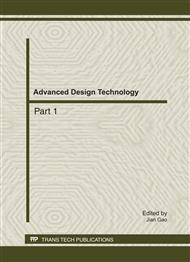[1]
He Chuan, Zhang Peng, Chen Liqiong. TRIZ Applied in Conception Design [J]. Journal of Sichuan University (Engineering Science Edition), 2003, 35(5): 19-23. In Chinese.
Google Scholar
[2]
Liu Xiaomin, Tan Runhua. Research on Product Innovation Design Driven by Current Reality Tree, Contradiction Resolution Diagram Using TOC Model [J]. Chinese Mechanical Engineering, 2008, 19(12): 1442-1445. In Chinese.
Google Scholar
[3]
Jiang Liang, Sun Tiebing, QuFuzheng. Study on Ontology Based Technical Innovation [J]. Chinese Mechanical Engineering, 2008, 19(15):1853-1857. In Chinese.
Google Scholar
[4]
Yang Yu, Yang Jie, Wang Xiaolei, etc. Customer Collaborative Product Innovation Design Method based on TRIZ [J]. Computer Integrated Manufacturing Systems, 2010, 16(1): 8-16. In Chinese.
Google Scholar
[5]
GaoChangqing, Huang Kezheng, Zhao Fang, etc. Research on Fast Innovation Design Method of Structure Based on CBR [J]. Chinese Mechanical Engineering, 2007, 18(24): 2907-2913. In Chinese.
Google Scholar
[6]
Wang Jiqiang, Wen Zhengzhong, Sun Huali. Research on the Computer Aided Creative System Based on TRIZ and Cases [J].Journal of Xidian University, 2003, 30(6): 827-830. In Chinese.
Google Scholar
[7]
Yang Bojun, TianYumei, Tan Runhua, etc. Research and Development of CAI System Based on Standard Solutions [J]. Chinese Mechanical Engineering, 2009, 20(6): 704-708. In Chinese.
Google Scholar
[8]
Huang Zhaofei, Li Yan, Xiong Yan, etc. Research on Patent Knowledge Base Systems for Creative Design [J]. Machinery Design and Manufacture, 2009, (9): 240-242. In Chinese.
Google Scholar
[9]
Sawaguchi, M.Study of effective new product development activities through combination of patterns of evolution of technological system and VE [J/OL]. TRIZ Journal, 2001, http://www.triz-journal.com/archives/2001/05/f/index.htm.
Google Scholar
[10]
Moehrle, M.G., Lessing, H. Profiling technological competencies of companies: A case study based on the theory of inventive problem solving [J]. Creativity & Innovation Management, 2004, 13(4): 231-239
DOI: 10.1111/j.0963-1690.2004.00312.x
Google Scholar
[11]
Tan Runhua, Ma Jianhong, Zhang Huangao, etc. Macro Process Model for Product Conceptual Design Driven by Technological Evolution [J]. Chinese Mechanical Engineering, 2003, 14 (11): 1-7. In Chinese.
Google Scholar
[12]
G. S. Altshuller. Suddenly the Inventor Appeared [M]. Technical Innovation Center, 1994.
Google Scholar
[13]
Chen, J.L., 2002. Green evolution rules and ideality laws for green innovative designof products. In: Fourth International [C]. Symposium on Going Green-CareInnovation.
Google Scholar


